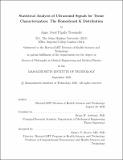Statistical analysis of ultrasound signals for tissue characterization : the Homodyned K Distribution
Author(s)
Tresansky, Anne Joyal Pigula.
Download1227276708-MIT.pdf (3.652Mb)
Alternative title
Homodyned K Distribution
HK Distribution
Other Contributors
Harvard--MIT Program in Health Sciences and Technology.
Advisor
Brian W. Anthony.
Terms of use
Metadata
Show full item recordAbstract
Diagnostic ultrasound (US) is a safe and inexpensive imaging technology that is widely used for qualitative assessment of anatomic features much larger than a wavelength, at least several millimeters in size. Statistical analysis of US envelope signals can provide information about scattering from structures that are smaller than a wavelength, and can therefore provide information on tissue composition and organization that would otherwise require a biopsy. The Homodyned K (HK) distribution is the most general in the family of random walk envelope distributions, which are strongly grounded in a physical modeling of scattering and therefore are ideal for tissue characterization purposes. In this thesis, several issues are considered that relate to the implementation and interpretation of the HK distribution. The physical interpretations of the HK parameters are explored, providing greater context and understanding for clinical applications. A novel parameter estimation algorithm based on the Levenberg-Marquardt curve-fitting algorithm is presented, and it is shown to be more robust in the presence of image artifacts than the gold standard. The effects of a single-element US imaging system on HK parameters are characterized, enabling calibration and therefore system-independent measurements. Finally, two animal studies are presented that use HK parameters to characterize skeletal muscle and liver in mouse models. These results represent progress towards implementing the HK distribution as a system-independent, clinically useful technology.
Description
Thesis: Ph. D. in Medical Engineering and Medical Physics, Harvard-MIT Program in Health Sciences and Technology, September, 2020 Cataloged from student-submitted PDF version of thesis. Includes bibliographical references (pages 101-121).
Date issued
2020Department
Harvard University--MIT Division of Health Sciences and TechnologyPublisher
Massachusetts Institute of Technology
Keywords
Harvard--MIT Program in Health Sciences and Technology.